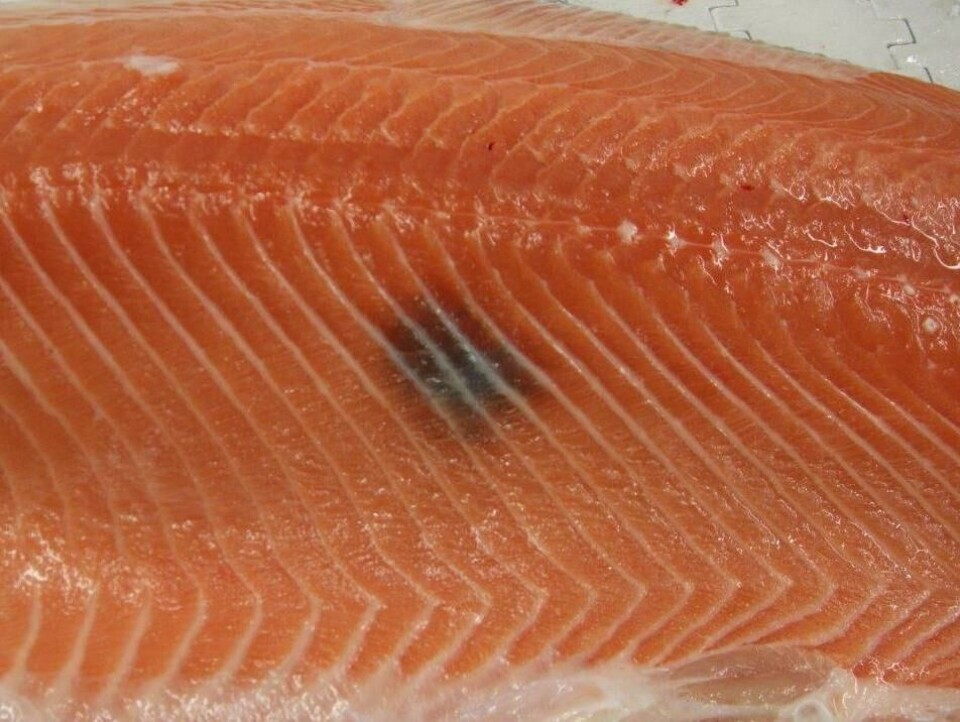
PRV ‘probably linked to black spots’ in salmon
A new study has shown that piscine orthoreovirus (PRV) infection alone is not enough to initiate the formation of black spots in salmon fillets but seems to explain a larger proportion of the more pronounced forms of black spots.
Red spots seem to give rise to black spots, and the reason for the formation of red spots is still unclear, reports Norway’s Fisheries and Aquaculture Research Fund (FHF) on its website.
Researchers point out that dark spots in salmon flesh cause major losses to the industry. An article published in 2015 showed there was a correlation between the presence of PRV and melanin and blood staining in salmon fillets. The 2015 study did not conclude whether PRV is the primary cause of melanin and blood staining, and also whether PRV is also involved in the earlier stages of red spots that turn into dark spots.
The newer project aimed to further enhance this context. If a relationship can be documented between the presence of PRV and the development of muscle damage that results in melanin staining and that PRV turns out to be the primary cause of the changes, this will provide an additional important incentive to take measures to limit / reduce the occurrence of PRV.
Huge losses
If PRV turns out to be not the primary cause but enhances the development of staining, a fight against PRV will still have a positive effect. Melanin staining is one of the main reasons for downgrading of fillets and the industry estimates that the losses are around NOK500 million (£47m) per year.
The project follows up both FHF’s commitment to causality around dark spots and research into the importance of PRV for the aquaculture industry. It is further rooted in the NMBU Veterinary College’s focus on research on fish diseases and the importance of viruses in the aquaculture industry, and Marine Harvest’s research efforts to solve the problem. The project has been led by Erling Olaf Koppang, of NMBU.
PRV not always found
FHF writes that in this project, a population of production fish was followed from sea-to-slaughter with a number taken out and examined throughout the production phase. The fish were PRV-negative when set out. At the beginning of the sea phase, the changes in the muscle to the fish were modest and without inflammation, and most spots that were found were red. The proportion of red-spot fish was relatively stable throughout the trial period, averaging 3.7%.
All degrees of red spots were present from the first withdrawal, and no pattern was detected between different degrees of these spots relative to the PRV status or macroscopic appearance. From that, researchers conclude that the PRV status of the fish does not influence the occurrence and manifestation of red spots.
The prevalence of black spots had an increasing trend throughout the experiment. The last withdrawal was 14 months after set-out. By microscopy it became evident that there is a large variety of tissue changes within the category of “black spots”, ranging from undetectable changes to severe inflammatory changes that have been previously described.
Not all black spots are the same
The changes could exist with and without pigmented cells, showing that something that one believes is a melanin stain is not necessarily that. On the contrary, such spots might only contain old connective tissue and not be subject to any inflammation. So, it is likely that light blemishes in the connective tissue can cause an area to be perceived as a melanin stain while in fact it is old scar tissue.
According to the researchers, these findings show that descriptions and registrations of black spots must always be followed by a histological characterisation.
Beyond the trial period, the black spots changed their character and became more pronounced and obvious during the autopsy of the fish and under the microscope. In these most pronounced and severe black spots with inflammation, PRV was always found, and it was the only infectious agent found in this study.
PRV infection alone is not enough
In one trial, fish were infected with PRV and other antigens, but no spots were detected in these fish. The project has shown that red and black spots can develop without detectable PRV infection, but black spots are highly different, and in the most serious forms the researchers always found PRV.
PRV infection alone is not enough to initiate the formation of black spots but seems to explain a larger proportion of the more pronounced forms of black spots. Red spots seem to give rise to black spots, and the reason for the formation of red spots is still unclear.
Searching for the primary cause
The results indicate that the most serious spots develop only with viruses present, but the cause of red spots apparently does not appear to be directly related to PRV infection. But not all fish have melanic spots when slaughtered even if they are PRV infected. Thus, the PRV infection itself is not sufficient to give melanin staining, writes FHF.
The causes of some individuals developing granulomatous spots may be due to the properties of the virus, fish or environment, or any combination of these. The initial causal factors of melanin staining were not found. Further studies are necessary to look for primary cause.
FHF earlier this year announced funding of NOK25.5m (£2.4m) for further research on melanin staining with a focus on trying to find primary cause. The trials have just been launched by Nofima and NMBU.






















































